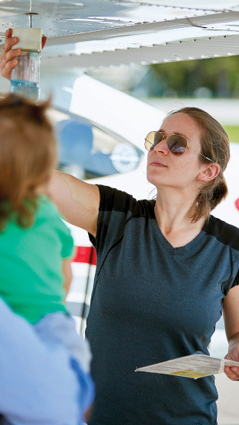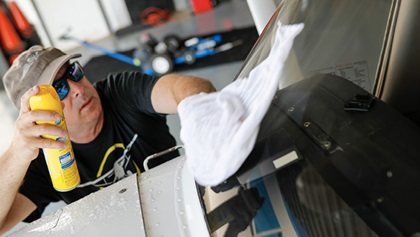
Publications
Special issue now available
2021 edition of ‘You Can Fly’ is published
By Kollin Stagnito
For the second year, Flight Training, AOPA’s multimedia brand dedicated to inspiring and educating student pilots, has produced a special issue titled You Can Fly: Your Path to Become a Pilot. Custom You Can Fly countertop displays filled with the special publication were distributed to more than 900 of the most active flight schools in the United States.
For those arriving at their local flight school dreaming about becoming a pilot, the publication sheds light on what to expect—from their first introductory flight in a general aviation airplane through initial training. Flight Training’s editors detail the steps to becoming a pilot, different career options, aircraft they can fly, gear they’ll need, pilot lingo, medical certification standards, the cost of flight training, and more.
The Flight Training team thought about the questions someone interested in learning to fly might ask—and provided straightforward answers with plenty of colorful illustrations and amazing photography.
Additionally, the You Can Fly issue contains an offer for a free AOPA student pilot trial membership. The free membership includes a subscription to Flight Training magazine (print or digital), the Flight Training weekly newsletter, an enhanced members-only website with premium aviation training content, and a student pilot helpline for one-on-one support.
If you know of someone who might be interested in learning to fly, encourage them to access a digital version of the You Can Fly issue at ft.aopa.org/youcanfly. Flight schools that did not receive a countertop display can request one, while supplies last, at [email protected].
Email [email protected]
Details: 260,000
The number of new pilots projected to be needed in the U.S. aviation industry in the next 10 years.
 MEET SARAH DEENER,
MEET SARAH DEENER,
AOPA DIRECTOR OF PUBLICATIONS
Sarah Deener is the AOPA director of publications, serving as managing editor of AOPA Pilot and Flight Training magazines as well as shepherding special projects such as the You Can Fly special issue and Freedom to Fly: The History of AOPA and General Aviation. She joined AOPA in 2009 in the eMedia division and was named managing editor in publications in 2015. She is an instrument-rated commercial pilot, a mother of two, and a master’s graduate of the Columbia School of Journalism. Her story “Start Here” was a finalist in the prestigious Folio: magazine awards in 2019.
AOPA Air Safety Institute
More than a number
Aircraft ‘true’ age versus factory age
By Alicia Herron
Which would you rather buy: a Cessna 150 with a history of 10,000 hours and an IFR panel, or a single-owner Cessna 150 that still has an ADF? A strictly freshwater floatplane or an ocean-flying seaplane? A taildragger with the original (if slightly nicked) fabric, or one with a brand-new paint job? Every option could be the right one for you, if you know the situation you’re getting into.
A history of 10,000 hours could mean the Cessna 150 has been used for flight training—and subject to all sorts of landings. Saltwater puts wear and tear on a floatplane more quickly than freshwater-only flying. And sometimes, fresh paint on a taildragger means it might have a history of damage, like a recent ground loop. Each of these aircraft could have been manufactured the same year, but with their varied histories, each has aged differently.
All aircraft accumulate fatigue and experience the effects of aging—how much aging depends on how they are used, maintained, and stored, and if they’ve experienced any damage. With enough use—and without inspection, repair, or replacement—any component could eventually fail. And the effects of aging aren’t always easy to see.
Regardless of when an aircraft rolled off the assembly line, the true age of an aircraft is more than just a number. A variety of factors contribute to its true age—including airframe and engine times—which may not be the same as its age in calendar years. High-stress flight activity—such as flight instruction, aerobatics, and skydiving ops—or poor care over time increases the effects of aging.
 The following five steps will help your aircraft live a long and a healthy life, slow the effects of aging, and make it a more reliable (and safer) airplane to fly.
The following five steps will help your aircraft live a long and a healthy life, slow the effects of aging, and make it a more reliable (and safer) airplane to fly.
- Keep it clean. Clean out any dirt and grime on the inside and outside of the aircraft. Most aircraft information manuals have a section on handling, service, and maintenance, which include information on cleaning the aircraft. Also, it’s best to buy airplane-specific cleaning products. Be sure to protect the aircraft’s windshield as well and avoid cleaning in a circular motion.
- Be an inspector. Regularly inspect the aircraft for any symptoms of aging, such as skin deformities, defects, or damage. If your aircraft is stored in a hangar, stand behind the tail of the aircraft with the hangar door open during the day. Viewing the surface of the aircraft from this position allows you to spot any surface damage that could exist, such as small dents or spot painting. This inspection method can also be performed outdoors, but damage or defects may be more difficult to detect.
- Be prepared. Flying to another airport? Remember to pack oil, tiedowns, chocks, and an aircraft cover to help protect your aircraft when away from its home base.
- Monitor and maintain. Detecting a problem early can help save money on repair costs. Change the oil regularly and monitor oil consumption. Keep the tires properly inflated—under-inflated tires wear faster. Monitor the engine gauges and listen for unusual sounds. And learn about what maintenance you can do as the owner.
- Fly! Keeping the aircraft and its engine parts in motion deters the buildup of corrosion and contaminants. This is especially important in warm, humid climates. Plus, it’s a great excuse to go flying!
With knowledge and care, you’ll be able to slow the effects of aging, and help keep your airplane healthy and reliable for years to come.
airsafetyinstitute.org/spotlight/agingaircraft
Email [email protected]
Turn on your notifications
Fly with AOPA
Partner Content
SiriusXM or ADS-B?

Whether you fly light sport, rotary wing, jet, single-engine piston, or anything in between, you have a choice when it comes to your inflight weather. The 2020 ADS-B mandate does not require you to use ADS-B/FIS-B weather—you are free to choose SiriusXM, ADS-B/FIS-B, or both. There are differences between ADS-B and SiriusXM Aviation weather that may directly impact your flight. Visit this webpage to see the differences between the two weather services at each stage of flight to help you decide the service that is right for you.
aopa.org/pilot/siriusorADS-B
AOPA Pilot Passport
Derby days
 The “first Saturday in May” is an important day for those who enjoy horse racing—and an important day in Kentucky. To recognize that passion, the AOPA Pilot Passport program challenges pilots to check in at airports in the Bluegrass State throughout May.
The “first Saturday in May” is an important day for those who enjoy horse racing—and an important day in Kentucky. To recognize that passion, the AOPA Pilot Passport program challenges pilots to check in at airports in the Bluegrass State throughout May.
Use the AOPA app’s Pilot Passport feature to check in at Kentucky airports in May, send in your photos, and you could be a winner. The top participant with the most check-ins in Kentucky will win a $100 AOPA Pilot Gear gift certificate.
The AOPA Pilot Passport program on the AOPA app encourages pilots to check in at different types of airports; land at airports across your state; visit airports across the country; and share your experiences by rating the airport, uploading photos, and posting comments on social media (use #AOPAPilotPassport in your posts).
aopa.org/travel/pilot-passport
Post of the month
Light up your days
 As the days get longer put the extra daylight hours to good use by flying to more airports each day and by checking in upon arrival with #AOPAPilotPassport. #flywithaopa @pilot.indy and @siannarenee
As the days get longer put the extra daylight hours to good use by flying to more airports each day and by checking in upon arrival with #AOPAPilotPassport. #flywithaopa @pilot.indy and @siannarenee
Tag @flywithaopa for your chance to be featured on this page.

Looking for more?
Instagram @flywithaopa, Twitter: @aopa, Facebook: AOPA: your freedom to fly, AOPA Live
Member Products and Services
Medically Speaking
Updates on medical certification policy
Making the process easier
By Gary Crump
The new federal air surgeon, Dr. Susan Northrup, and her deputy, Dr. Brett Wyrick, are now fully engaged, and AOPA has met virtually with them several times since late last year. We have some common goals to help improve the FAA medical certification system and steps are in place to reach those objectives.
The FAA has added a group of oral diabetes medications to the acceptable medications for medical certification. When a new class of diabetes medications—the sodium glucose co-transporter inhibitors (SGLT2)—came on the market several years ago, they were not initially allowed for use by pilots because of the way these drugs perform. The medications inhibit reabsorption of glucose in the kidney in order to lower blood sugar. During this process, sodium is reduced, and low sodium can result in symptoms that could adversely impact flight safety. After study, the FAA has now determined that they can safely be used by pilots.
As medical certification standards and practices have evolved, the FAA, with input from AOPA, created the AME-Assisted Special Issuance (AASI), which allows AMEs to reissue medical certificates issued under a special issuance after the FAA had issued the initial authorization for special issuance. A welcome recent change affects the AASI process for applicants who have had a single heart valve replacement or coronary artery disease. These are significant changes in that cardiac AASIs originally applied only to third class special issuances. Now, AMEs can reissue medical certificates for Classes 1, 2, and 3 after the FAA has completed initial clearance for these cardiac conditions. Pilots will still need to see their cardiologists for the annual cardiovascular evaluation, however, the pilot can make an intermediate visit to the AME, who can review the records and issue a new time-limited certificate.
The CACI (Conditions AMEs Can Issue) is another important tool. There are currently 19 medical conditions covered under the CACI protocol. These conditions used to require a special issuance but are now considered for “regular” medical certificate issuance at the time of examination. When the FAA places you under a CACI, the letter will include a link to the appropriate report from your treating physician at the time of your regular FAA flight physical.
CACI and AASI are great tools that have made a small dent in the medical certification bureaucracy. AOPA and the federal air surgeon and her staff are committed to working together to continue to move the needle in the right direction to improve the medical certification process.
Gary Crump is the senior director of medical certification for AOPA Pilot Information Center.


